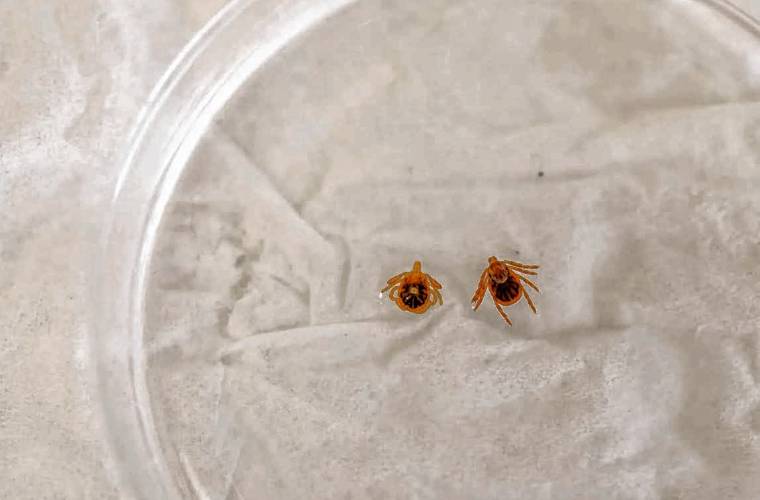Tick bites are sending more people in the Northeast to the emergency room this year

Tony Spinelli/Connecticut Public Ticks under a microscope at the Connecticut Agricultural Experiment Station in New Haven. Connecticut Public — Tony Spinelli
| Published: 07-27-2023 6:19 PM |
Connecticut’s, tick-season, when ticks are most active, used to just be during the spring and summer. But with milder, shorter winters across the Northeast, ticks are now a year-round problem.
Earlier this month, Connecticut officials were forced to close Pleasure Beach in Bridgeport due to a tick infestation at the park. Four different species of disease-carrying ticks were found, according to the New Haven based Connecticut Agricultural Experiment Station. The state was advised to target and spray certain infested areas, cut back vegetation and post signs warning visitors not to walk in areas of dense vegetation.
The data from the U.S. Centers for Disease Control and Prevention’s online tick tracker shows that, in the Northeast, visits to the Emergency Department for tick bites are up more than 30% from last year. This means people enjoying the outdoors need to be vigilant, experts say.
“The best way to avoid getting sick is to just avoid getting bit by a tick in the first place,” said Dr. Grace Marx, medical director with the CDC’s Division of Vector-borne Diseases. “Being aware when ticks are active, and taking the right steps to prevent tick bites in the first place, is really the way to go.”
The CDC’s online, interactive tool allows users to track and visualize tick-borne disease data in the United States. A user can answer a series of questions covering topics such as tick attachment time and symptoms and then, based on the user’s responses, the tool provides information about recommended actions and resources.
To reduce chances of being bitten by a tick, the CDC recommends using EPA-registered insect repellents such as DEET and checking body parts and clothing for ticks after being exposed to potentially tick-infested areas, including the backyard.
“When you come inside, take a shower soon after you come indoors or within a couple of hours after coming indoors to reduce your risk of getting Lyme disease and other tick-borne diseases,” Marx said.
When a tick is found attached to the skin, she said removing it as soon as possible is key to preventing disease.
Article continues after...
Yesterday's Most Read Articles
 Stolen White River Junction weathervane returns after 40 years
Stolen White River Junction weathervane returns after 40 years
 Enfield Zoning Board approves variances for 300-unit development
Enfield Zoning Board approves variances for 300-unit development
 Beilock’s leadership divides students; ‘no confidence’ narrowly passes
Beilock’s leadership divides students; ‘no confidence’ narrowly passes
 Homeless Upper Valley couple faces ‘a very tough situation’
Homeless Upper Valley couple faces ‘a very tough situation’
“You can just do this at home with a plain set of fine-tipped tweezers,” Marx said. “Different pathogens transmit at different times. For example, for Lyme Disease, which is the most common tick-borne disease in the United States, it will take at least 24 hours for that bacteria to transmit. But there are other pathogens that can transmit in much shorter periods of time, including some on the skin for just minutes of attachment.”
Another tool to protect against ticks, according to the CDC, is treating clothing with a tick-repellent chemical containing 0.5% permethrin, which typically stays active through several washings.
Of all the tick-borne diseases, Lyme disease is by far, the most common, representing upwards of 80% or more of all tick-borne diseases in the U.S., according to the CDC.
“There are other tick-borne diseases as well,” said Dr. Marx, “and those include things like ehrlichiosis, anaplasmosis, tularemia, Powassan virus disease, so there really is a whole number of them.”
“When you get bit by a tick, it’s important to come in to your health care provider with information. And if you get sick after a tick bite, go in as soon as possible for evaluation,” Marx said.
Symptoms of Lyme Disease and other tick-borne illnesses may develop within a few weeks after a tick bite. It’s important to watch out for signs of a “bullseye rash” on the skin, as well as fever, nausea, headache and other symptoms that mimic influenza and arthritis, Marx said.
In Connecticut, residents can submit tick samples to The Connecticut Agricultural Experiment Station for testing to detect any diseases. Local health department contact information can also be found at the state Department of Public Health. Instructions on how to submit a tick and the necessary forms required to do so can be found through the state’s Tick Submission Form.

 Enfield Shaker Museum renovations underway
Enfield Shaker Museum renovations underway Art Notes: Canaan Meetinghouse showcase brings musicians and listeners together
Art Notes: Canaan Meetinghouse showcase brings musicians and listeners together A Look Back: Upper Valley dining scene changes with the times
A Look Back: Upper Valley dining scene changes with the times
